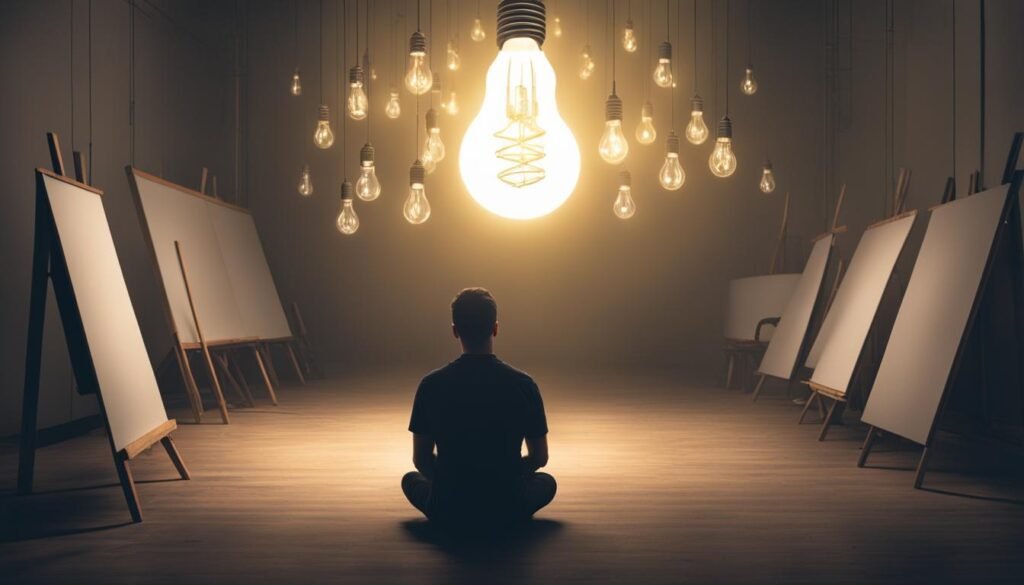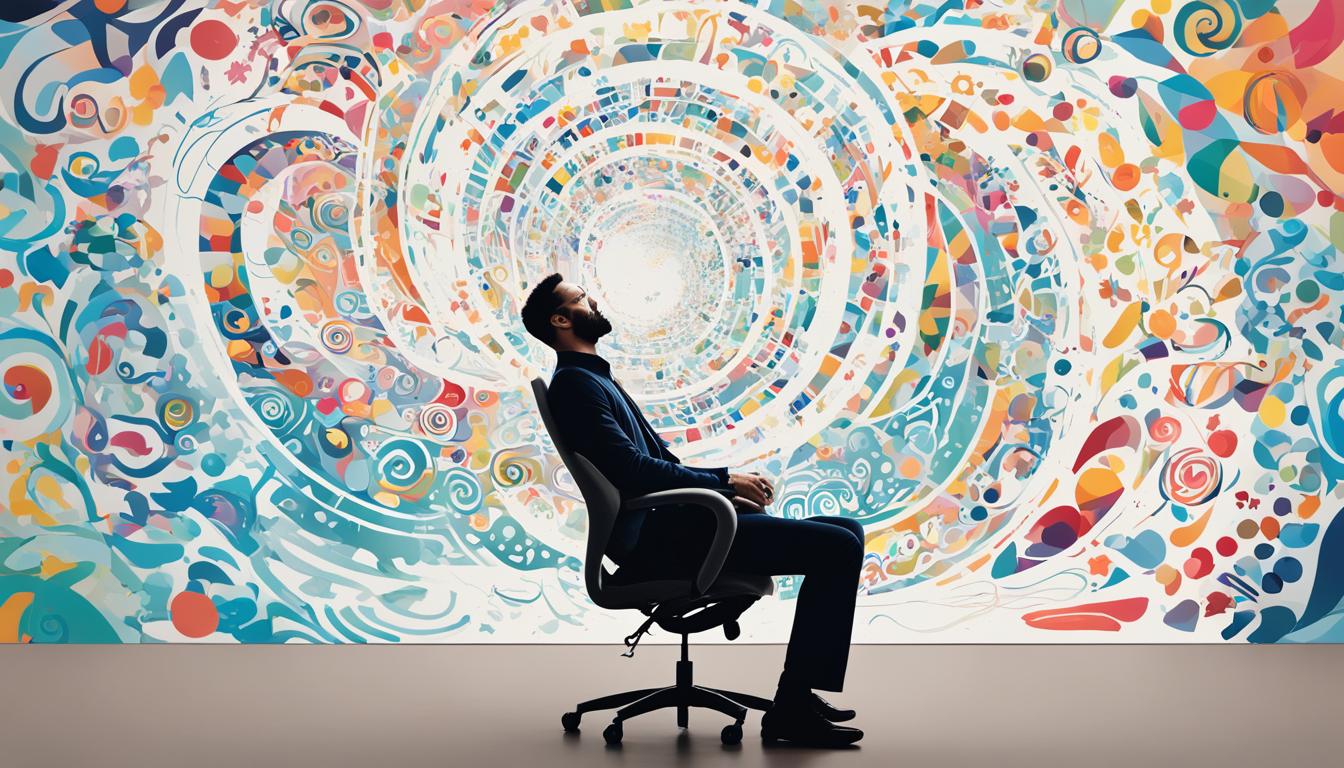Visualization techniques have been used for millennia to achieve life goals, big and small. They work by intentionally bringing events, people, and objects into consciousness with intense focus. Visualization techniques are founded on proven principles of psychology and neuroplasticity, activating the creative potential of the subconscious and programming the brain to recognize the necessary resources for achieving goals. Famous examples, such as Lebron James and Jim Carey, showcase the power of visualization techniques in manifesting success.
Key Takeaways:
- Visualization techniques tap into the creative potential of the subconscious mind.
- They activate neuroplasticity, allowing the brain to recognize resources for achieving goals.
- Visualization has been used by successful individuals like Lebron James and Jim Carey.
- It has a long history, dating back to ancient Rome and Buddhist practices.
- Visualization can be a powerful tool for manifesting success and unlocking creativity.
The Origins of Visualization Techniques
Visualization techniques have likely been around for millennia and can be traced back to the idea of the “mind’s eye,” developed by the Roman statesman Cicero. In the field of psychology, the concept of the mind’s eye refers to the ability to visualize images in the absence of external stimuli, using the power of imagination.
Buddhism, which dates back over 2,000 years, also recognizes the significance of visualization techniques in spiritual practice. One popular visualization technique in Buddhism is Loving Kindness Meditation, where practitioners visualize sending love and compassion to themselves and others. This practice enhances empathy and cultivates a positive mindset.
“Visualization is a powerful tool for unlocking creative potential and enhancing personal growth.”
In the late 1970s, visualization techniques gained widespread popularity in the New Age movement with the publication of Shakti Gawain’s best-selling book, “Creative Visualization.” Gawain explored the link between visualizing goals and manifesting them in reality, inspiring many to embrace visualization as a means of personal growth and empowerment.
Through these various cultural and historical influences, visualization techniques have evolved and adapted to suit modern needs and aspirations.
The Origins of Visualization Techniques
| Culture/Philosophy | Time Period | Key Concepts |
|---|---|---|
| Roman | Cicero (1st century BC) | The concept of the “mind’s eye” |
| Buddhism | Over 2000 years ago | Loving Kindness Meditation |
| New Age | Late 1970s | Shakti Gawain’s “Creative Visualization” |
Understanding Visualization
Visualization is a powerful technique that involves creating mental images or representations in our mind’s eye. By harnessing the science of visualization, we can tap into the brain’s neuroplasticity and create new neural pathways based on imagined or visualized experiences.
When we visualize, our brains do not distinguish between what is real and what is imagined. As a result, visualizations have the potential to activate neural pathways as if the corresponding real events were occurring. This phenomenon shows how visualization can influence our perception and create new possibilities.
One key component of visualization is the reticular activating system (RAS) in the brain. The RAS acts as a set of filters that focus our attention on specific stimuli. When we visualize, we direct our RAS to search for opportunities and resources that align with our visualizations, helping us notice relevant information and increasing our chances of manifesting our goals.
The science of visualization makes use of the brain’s plasticity and the interconnectedness of neural pathways. The concept of neuroplasticity refers to the brain’s ability to reorganize itself and form new connections in response to experiences and mental activities. By repeatedly visualizing desired outcomes, we reinforce and strengthen the neural pathways associated with those experiences.
“Visualization is a powerful tool that taps into the brain’s ability to rewire itself and create new neural connections based on imagined experiences.”
Research on the efficacy of visualization techniques has shown promising results. For example, a study conducted by neuroscientists at Harvard Medical School found that visualizing a specific motor action can activate similar neural pathways to actually performing that action, leading to improved motor performance.
In another study, researchers at Stanford University discovered that athletes who used visualization techniques, such as mentally rehearsing a golf swing, showed significant improvements in their performance and accuracy on the golf course.
Visualization can be used in various areas of life, from sports and performance enhancement to personal growth and goal achievement. By understanding the science behind visualization and utilizing it effectively, we can tap into the power of our minds and unlock our full creative potential.
Benefits of Visualization Techniques
Visualization techniques offer a wide range of benefits across different areas of life. Let’s explore some of the key advantages:
- Enhanced athletic ability
- Better accuracy and performance
- Decreased mental distress and anxiety
- Pain management and relief
- Stress reduction and relaxation
- Improved concentration and focus
- Increased self-confidence and motivation
Benefits of Visualization Techniques
Visualization techniques offer a wide range of benefits that can positively impact various aspects of your life. By incorporating visualization into your daily routine, you can unlock your full potential and achieve success in diverse areas, from athletics to mental well-being. Let’s explore some of the key benefits of visualization techniques:
Enhanced Athletic Ability
If you engage in sports or athletic activities, visualization techniques can be a game-changer. Athletes who visualize themselves performing at their best have been shown to experience enhanced athletic performance. By vividly imagining yourself executing perfect moves, scoring goals, or nailing a routine, you can train your brain to enhance muscle memory and improve your overall physical abilities.
Better Accuracy
Visualization can also help improve accuracy in various tasks, such as shooting, throwing, or hitting targets. When you visualize yourself hitting the bullseye or scoring the winning goal, you are training your brain to focus on precision. This mental rehearsal can lead to improved hand-eye coordination and increased accuracy in your actions.
Decreased Mental Distress
Visualization techniques have been found to be effective in reducing mental distress and promoting a sense of calmness. By creating a mental image of serenity, peace, or a safe space, you can alleviate stress, anxiety, and other negative emotions. Visualizing positive scenarios can help shift your mindset and bring a sense of tranquility into your everyday life.
Pain Management
Visualization techniques have been successfully used as a complementary approach in pain management. By focusing your imagination on soothing visuals or imagining the pain dissipating, you can effectively reduce discomfort. Visualization can help divert your attention from the pain, improve relaxation, and promote healing.
Stress Reduction
In today’s fast-paced world, stress is a common issue that can negatively impact your overall well-being. Visualization techniques offer a valuable tool for stress reduction. Engaging in guided visualizations or picturing yourself in serene environments can trigger your body’s relaxation response, counteracting the effects of stress hormones and promoting a sense of calm.
Improved Concentration
Visualization techniques can also improve your concentration and focus. By creating a mental image of a specific task or goal, you can train your brain to filter out distractions and sharpen your attention. This enhanced focus can lead to increased productivity and improved performance in various areas of your life.
Increased Self-Confidence
Visualization techniques can boost your self-confidence and belief in your capabilities. By visualizing yourself succeeding, achieving your goals, or overcoming obstacles, you program your mind for success. This positive visualization can instill a strong sense of self-belief, empowering you to face challenges with confidence and take action towards your desired outcomes.
Visualization techniques offer a powerful way to unlock your potential, improve your well-being, and unleash your creativity. By incorporating visualization into your daily routine, you can experience the numerous benefits it provides, from enhanced athletic ability to reduced stress and increased self-confidence.
| Benefits | Description |
|---|---|
| Enhanced Athletic Ability | Visualization techniques can improve athletic performance and physical abilities. |
| Better Accuracy | Visualization can enhance accuracy in tasks that require precision. |
| Decreased Mental Distress | Visualization techniques can reduce stress, anxiety, and negative emotions. |
| Pain Management | Visualization can be used as a complementary approach for managing pain. |
| Stress Reduction | Visualization techniques promote relaxation and help alleviate stress. |
| Improved Concentration | Visualization improves focus and concentration on specific tasks. |
| Increased Self-Confidence | Visualization techniques boost self-confidence and belief in one’s capabilities. |

Techniques for Effective Visualization
When it comes to enhancing your visualization practice, there are several techniques that can help you unlock your creative potential. These techniques include:
Mind Mapping
Mind mapping is a visual technique that organizes thoughts and ideas in a structured manner. It involves creating a central idea or concept and branching out into related sub-topics. Mind mapping allows you to visually explore connections and associations, stimulating your creativity and helping you generate new ideas.

Mental Imagery
Mental imagery involves creating vivid mental pictures or visual representations in your mind’s eye. By visualizing specific scenes or scenarios, you can activate your imagination and engage your senses. This technique allows you to tap into the power of mental imagery to enhance your visualization practice and manifest your desired outcomes.
Guided Visualizations
Guided visualizations involve following scripted narratives or audio recordings to visualize specific scenarios or experiences. These guided exercises can help you explore new possibilities, tap into your subconscious mind, and unlock your creative potential. Whether you’re looking to overcome challenges or envision future success, guided visualizations can be a valuable tool for effective visualization.
Vision Boards
Vision boards are visual collages that consist of images, words, and symbols representing your goals, aspirations, and desires. By creating a vision board, you can manifest your creative aspirations and reinforce your visualization practice. Vision boards serve as powerful visual reminders of what you’re striving to achieve, helping you stay focused and motivated.
By incorporating techniques such as mind mapping, mental imagery, guided visualizations, and vision boards into your visualization practice, you can enhance your creative abilities and unlock new possibilities. These techniques provide tangible and practical ways to harness the power of visualization and bring your dreams to life.
Applying Visualization in Daily Life
To make the most of visualization techniques, it is important to incorporate dedicated visualization practice into your daily life. By consistently engaging in visualization exercises and utilizing visualization tools, you can enhance your creative abilities and manifest your aspirations.
Setting Aside Specific Time
One way to incorporate visualization into your daily routine is by setting aside specific time for dedicated practice. Find a quiet and comfortable space where you can relax and focus on your visualization exercises. This could be in the morning before starting your day, during a break, or before going to bed. Consistency is key to reaping the benefits of visualization, so aim to practice it daily or several times a week.
Creating a Consistent Routine
Establishing a consistent routine can help reinforce regular visualization practice. Consider incorporating visualization into existing habits or activities. For example, you can visualize your goals while taking a walk or during your daily commute. By associating visualization with familiar routines, it becomes easier to make it a habit.
Utilizing Visualization Tools
Visualization tools can enhance the practice and effectiveness of visualization techniques. Here are some popular tools you can incorporate into your visualization practice:
- Vision Boards: Create a visual representation of your goals and aspirations by gathering images, words, and symbols that resonate with you. Arrange them on a board or wall to serve as a daily reminder of what you are working towards.
- Guided Audio Recordings: Use pre-recorded guided visualizations or meditations to help you navigate the visualization process. These recordings often provide gentle guidance, imagery, and affirmations to support your visualization practice.
By using visualization tools, you can amplify the impact of your visualization practice and strengthen the connection between your imagination and reality.
Remember, the key to effective visualization lies in consistency and dedication. By incorporating visualization into your daily life and utilizing visualization tools, you can tap into your creative potential, manifest your goals, and transform your life.
Conclusion
Visualization is a powerful tool that unlocks your creative potential. By harnessing the power of visualization, you can tap into your imagination, stimulate your subconscious mind, and foster innovation and out-of-the-box thinking. Whether you use techniques like mind mapping, mental imagery, guided visualizations, or vision boards, incorporating visualization into your daily practice can greatly enhance your creativity.
By integrating visualization techniques into your life, you open up endless possibilities and fuel your creative endeavors. Visualization helps you see beyond the surface and envision the future you desire. It allows you to visualize success, feel its emotions, and attract the necessary resources to manifest your goals.
So, start harnessing the power of visualization today. Take a few moments each day to close your eyes, visualize your dreams, and believe in their realization. Unlock your creative potential and watch as your imagination takes flight, propelling you towards new horizons of success.
Frequently Asked Questions
1. How can visualization techniques unlock creativity?
Visualization techniques tap into the brain’s neuroplasticity, activating the creative potential of the subconscious mind and fostering out-of-the-box thinking.
2. What are the origins of visualization techniques?
Visualization techniques can be traced back to ancient practices such as the concept of the “mind’s eye” developed by Cicero and visualization techniques in Buddhism. In modern times, visualization gained popularity through Shakti Gawain’s best-selling manual.
3. How does visualization work?
Visualization works by creating mental images or representations in the mind’s eye, activating neural pathways as if the corresponding real events were occurring.
4. What are the benefits of visualization techniques?
Visualization techniques offer numerous benefits, including enhanced athletic performance, improved accuracy, stress reduction, pain management, increased self-confidence, and improved concentration.
5. What techniques can I use for effective visualization?
Techniques such as mind mapping, mental imagery, guided visualizations, and vision boards can be used to enhance visualization practice and creative exploration.
6. How can I incorporate visualization into daily life?
It is important to dedicate specific time for visualization exercises, create a consistent routine, and utilize visualization tools such as vision boards or guided audio recordings to make visualization a regular practice.
7. What is the power of visualization in unlocking creativity?
By harnessing the power of visualization, individuals can tap into their imagination, stimulate their subconscious mind, and foster innovation and creative thinking.



